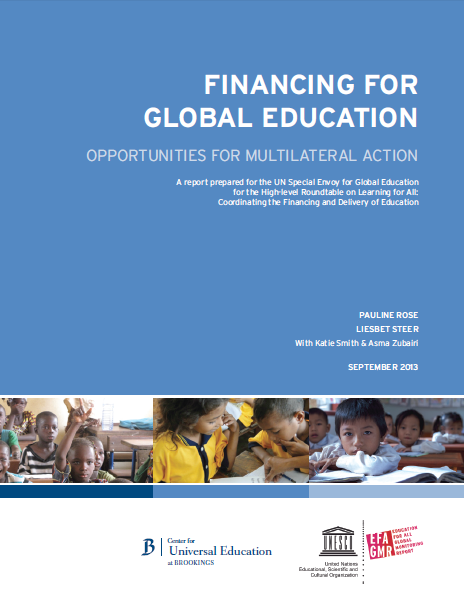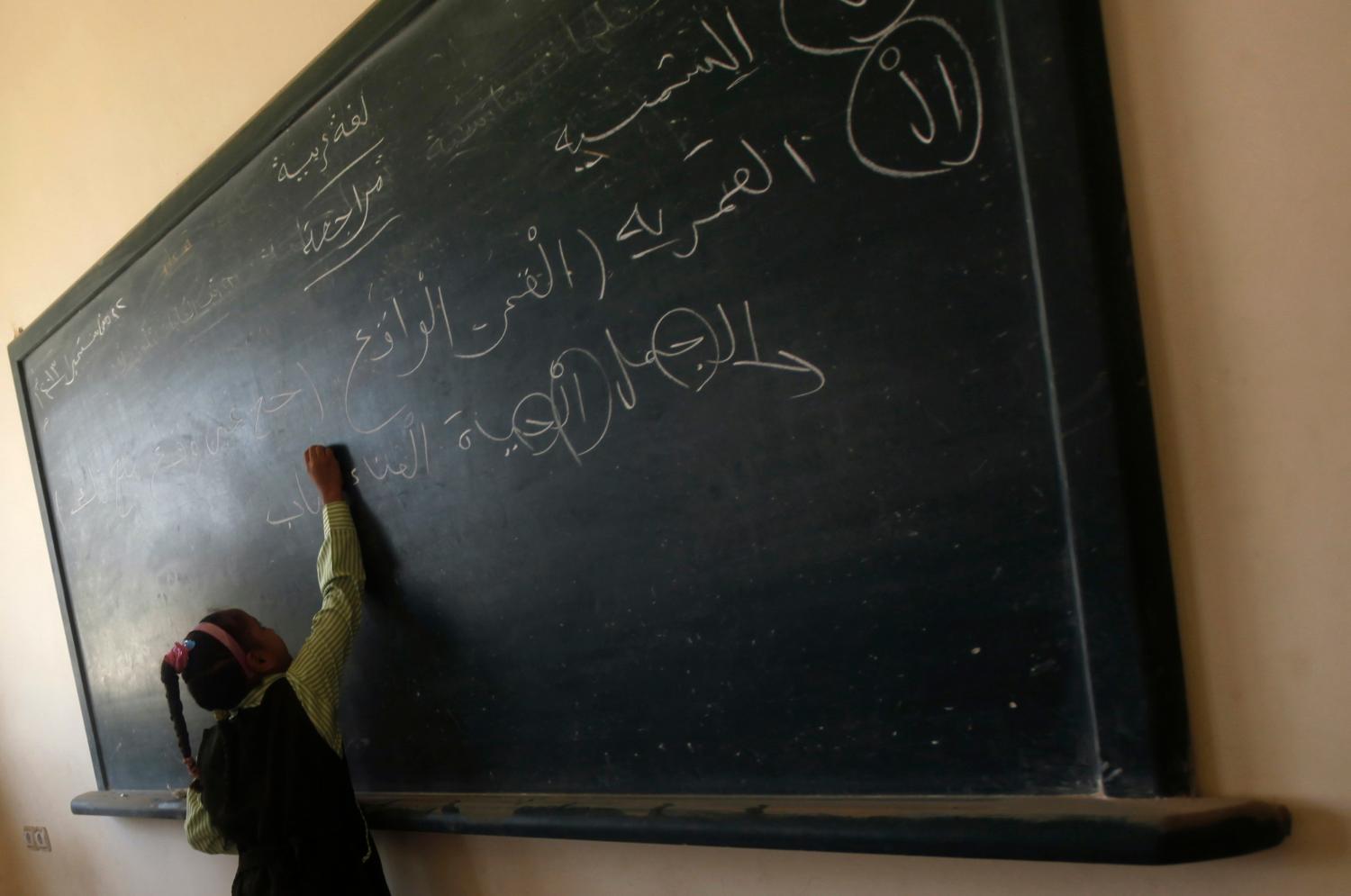EXECUTIVE SUMMARY
Access to good quality basic education for all children is a promise the global community must keep.
 This will require reaching the 57 million children that are currently out-of-school, many of them from marginalized and disadvantaged groups. It will require ensuring that children in school complete their education and are learning — currently 250 million children in school cannot read or count at basic levels. It can be done, and we know how to do it. Many more children are in school today than ever before, and over the past decade the number of out-of-school children fell by 45 million.
This will require reaching the 57 million children that are currently out-of-school, many of them from marginalized and disadvantaged groups. It will require ensuring that children in school complete their education and are learning — currently 250 million children in school cannot read or count at basic levels. It can be done, and we know how to do it. Many more children are in school today than ever before, and over the past decade the number of out-of-school children fell by 45 million.
While recognizing the complexity of the task and the need for a wide variety of solutions, this paper focuses on how the international community, and multilateral agencies in particular, can contribute through mobilizing the necessary financial resources and ensuring their effective use. After taking account of available domestic and donor resources, it is estimated that an additional $26 billion will be needed per year to make sure all children receive a basic education by 2015. This gap will need to be filled by domestic resources, as well as bilateral and multilateral donors. There is also opportunity for an increasingly important role for the private sector.
Based on data analysis and case studies of the six most important multilateral donors in education, this report explores the role they could play either through their own resources or through mobilizing others. Special attention is paid to 41 countries in greatest need. These countries include the 35 low-income countries whose own resources are limited, together with the 6 middle-income countries which are amongst the 10 countries with the highest out-of-school populations. Multilaterals’ significance in the aid architecture and their unique capacity to pool funding, convene donors and be a lender of last resort, provides them with a number of opportunities to play a significant role.
Public statements of multilateral institutions suggest a strong commitment to education. In addition, surveys of developing country stakeholders in governments, civil society and the private sector show a strong demand for education support more widely. However, despite this strong prioritization and demand there is evidence that multilateral support for basic education is slowing compared to other sectors and to bilateral donors. Moreover, some multilateral agencies have increasingly prioritized higher education over the past decade, putting pressure on basic education financing. This has led to a reduction in basic education’s share of the total education aid from multilateral institutions — from 62 percent at the beginning of the decade to 51 percent in 2011. Unless the overall envelope for multilateral aid is increased, there is a danger that growing support to new areas such as skills development will squeeze the scarce resources for basic education even further, to the detriment of the most disadvantaged.
Donors and multilateral agencies in particular, are strong advocates of internationally agreed aid effectiveness principles and are engaged in a number of country and global coordination mechanisms. Coordination at the country level is strongly promoted by the Global Partnership for Education through its support to Local Education Groups and the development of country-owned education sector plans. But despite significant efforts, education remains highly fragmented, leaving some countries with too many donors and high transaction costs and others with too few donors to generate a minimum level of support to meet needs. The number of donors active in education in the 41 countries in highest need ranged from 6 in the Central African Republic (CAR) to 23 in Tanzania. Nearly half of the countries in need have to coordinate with 15 or more donors in education. More than one-third of the donor relations in education in the 41 countries can also be considered as “non-significant” as defined by OECD-DAC.
While it is estimated to cost on average around $130 per year to provide a child with an acceptable quality of primary education in poorer countries, basic education aid disbursed per primary-aged child ranges from $7 in DRC to $63 in Haiti.
Lack of genuine coordination at the global and country level makes it much harder for multilateral donors, particularly those that are seen as the funders of last resort, to fill gaps in financing and target countries with highest needs. While multilateral donors do seem to prioritize countries in need more strongly than bilateral donors, there is significant variation. The EU disburses only 40 percent of its basic education aid to the 41 priority countries, compared with 84 percent for UNICEF to the same countries. Substantial variation is also found in the volume of aid disbursed to countries in need. While it is estimated to cost on average around $130 per year to provide a child with an acceptable quality of primary education in poorer countries, basic education aid disbursed per primary-aged child ranges from $7 in DRC to $63 in Haiti. Analysis also suggests that multilateral donors have not always been able to fill gaps left by bilateral donors. Amongst the 41 countries in need, 22 receive less than $10 per child from bilateral donors, even though needs are much larger. In only 6 of the 22 countries have multilaterals been able to significantly fill the gap.
This report makes no claim to provide comprehensive recommendations for filling the remaining financing gaps, nor does it claim that solutions to provide education for all involve financing alone. Rather it suggests five opportunities for action which could make a major contribution in enhancing the role that multilateral agencies can play. Detailed proposals are made under each of the following:
- Opportunity for Action #1: Inspire demand for more support for basic education. Decision-making in multilateral agencies is firmly anchored at the country level and program priorities are determined in close dialogue with country government and other development partners. When asked why multilateral support for education, and basic education in particular, was not greater, managers often cited the low level of country demand. However, multilateral client surveys suggest demand for basic education is very high, even for loan funds. Evidence also indicates that demand is felt more strongly by donors who already prioritize education, suggesting recipients direct their demand to those donors who are interested in responding to it. As is clear from other sectors such as governance and climate change—where demand is much weaker than in basic education but multilateral support is growing rapidly—demand can be created in a positive manner as part of deep partnerships and dialogue at the country level. Incentives need to be provided to country managers to inspire such demand for MDG priority areas, including basic education. Some good practices are emerging. In-country technical capacity in basic education is an essential element of efforts to increase demand and effective support.
- Opportunity for Action #2: Organize high level dialogue to target countries in need. One important role of multilateral agencies is to provide and attract high level global leadership to mobilize and coordinate support for countries in need. This high level coordination is particularly important in education, as the sector has a narrow donor base. The top 10 donors provide close to three quarters of all aid. This means that uncoordinated entry or withdrawal from the sector could have serious implications. Support for the elevation of Global Partnership for Education’s board membership to include high level representation of donors, alongside ministers of education from developing country partners, is one way to promote its power to bring about change. Continuation of the high level meetings as part of the UN Secretary General’s Education First Initiative could also help encourage this much needed high level dialogue and establish recommendations for concrete action.
- Opportunity for Action #3: Improve information and financial data. To facilitate the mobilization of additional resources, and ensure they are better spent, action is urgently needed to present a more complete picture of education financing. Multilateral agencies should support efforts to develop National Education Accounts as a matter of urgency. The technical leadership of UNESCO Institute for Statistics and International Institute for Education Planning, among other partners, in developing a shared approach to National Education Accounts is an important first step. To be effective, it will be vital that this work benefits from collaboration with other multilateral institutions, including those with experience in developing National Health Accounts who could contribute to the expansion and acceleration of this new initiative. Given its responsibility for ensuring financing gaps are filled, GPE could play a leadership role in coordinating the development of these National Education Accounts.
- Opportunity for Action #4: Catalyze domestic resources. Domestic resources will continue to be the most important source of finance for education. Multilaterals could play a stronger role in helping countries to mobilize resources and by ensuring that sufficient resources are allocated to human development, including education. The adoption and monitoring of financing goals could be a potential means of holding governments accountable.
- Opportunity for Action #5: Crowd in innovative finance. While innovative financing in development has been growing over the past decade, estimated to amount to over $50 billion between 2000 and 2008, education has not been a major beneficiary. Innovative finance with strong short-term profit motives will not be appropriate for education, but there are a number of other options the education sector could explore, including tapping into diaspora communities and private companies with long-term investment interests. Multilateral agencies could play a critical role in helping developing countries to navigate different types of innovative finance and facilitate partnerships between the government and private investors interested in supporting education.



